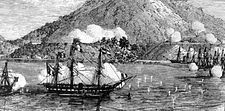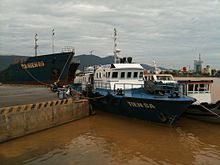- Da Nang Port
-
Da Nang Port Location Country Vietnam Da Nang Port (Vietnamese: Cảng Đà Nẵng) is a major port system located in Central Vietnam at the mouth of the Han River on the South China Sea, in the city of Da Nang. It is the third largest port system in Vietnam (after Saigon Port in Ho Chi Minh City and Hai Phong Port in Hai Phong). Da Nang Port lies at one end of the East–West Economic Corridor, an economic corridor connecting Vietnam with Laos, Thailand, and Burma. Vietnam National Shipping Lines (Vinalines) is the port's authority.[1]
In 2008, Da Nang Port handled 2.7 million tons of cargo, of which 1.2 million tons were exports, 525,900 tons were imports, and 985,600 tons were domestic cargo. Over 29,600 passengers passed through the port in 2008, a significant increase over previous years.[1] Despite the fact that the port's infrastructure is not specifically designed to accommodate cruise ships, the number of large cruise ships docking at Da Nang Port has increased in recent years.[2] In the first two months of 2010 alone, 12 cruise ships docked in Da Nang, carrying 6,477 passengers.[3]
Contents
History
Da Nang has been a port city for many centuries, long before the first arrival of European traders in the 16th century. One of the first Europeans to visit the city was Portuguese explorer Antonio De Faria, who anchored in Da Nang in 1535. De Faria was one of the first Westerners to write about the area, and through his influence Portuguese ships began to call regularly at Hoi An, which was then a much more important port than Da Nang.[4]
Throughout the 17th and 18th centuries, French and Spanish traders and missionaries regularly made landfall at Hoi An, just south of Da Nang. In 1787, Emperor Gia Long concluded a treaty with French King Louis XVI, whereby he ceded Da Nang Port to the French in return for a promise of military aid.[5]
Following the edict of Emperor Minh Mạng in 1835 prohibiting European vessels from making landfall or pursuing trade except at Han Port, Da Nang quickly superseded Hoi An to became the largest commercial port in the central region.[6]
In 1847, French vessels dispatched by Admiral Cécille bombarded Da Nang, ostensibly on the grounds of persecution of Roman Catholic missionaries by the forces of Emperor Thiệu Trị.
In August 1858, again ostensibly due to the persecution of Catholic missionaries—this time by Emperor Tu Duc—French troops led by Admiral Charles Rigault de Genouilly seized Da Nang Port as part of the punitive Cochinchina Campaign. The French overpowered the Vietnamese stationed in Da Nang, swiftly occupying the city and Tien Sa Peninsula (now called Son Tra Peninsula). Da Nang (which the French called Tourane) and its port would remain in French hands until 1954, upon the formal dissolution of Indochina.[6]
Facilities
The Da Nang Port system consists of two main terminals (Tien Sa Seaport, and Song Han Terminal) and an additional freight warehouse, Tho Quang Station. The total area of the port system is 299,256 m2 (3,221,160 sq ft), of which 29,204 m2 (314,350 sq ft) is warehouse space and 183,722 m2 (1,977,570 sq ft) is yard space.[7]
In recent years, the number of large cruise ships docking at Da Nang Port has increased, despite the fact that the port's infrastructure is not specifically designed to accommodate cruise ships.[2] Due to these limitations, cruise ships generally make short stays—about 2 or 3 days at most.[8] In the first two months of 2010, 12 cruise ships were reported to have docked in Da Nang, carrying 6,477 tourists, mainly from Europe, the U.S., Canada and Australia.[3]
Tien Sa Seaport
Tien Sa Seaport has a navigation depth of 11 m (36 ft), and is able to receive medium range tankers of up to 45,000 DWT, as well as container ships of up to 2,000 TEUs and large cruise ships of up to 75,000 GRT. A 450 m (1,480 ft) breakwater provides protection from high waves and monsoons. The terminal has five berths in total: four berths, located along two finger piers, of 185 m (607 ft) each, and one 225 m (738 ft) berth on a wharf along the shore, for a total of 965 m (3,166 ft). Throughput capacity at this terminal is over 4.5 million tons per year.[9][10][1] Tien Sa terminal contains 13,665 m2 (147,090 sq ft) of warehouse space and 138,251 m2 (1,488,120 sq ft) of yards.[7]
Song Han Terminal
The approach to Song Han Terminal is 12 nautical miles (22 km) long with a navigation depth of 6-7m. The terminal has five berths, located along the shore; berth No. 1 is 140 m (460 ft) long, berths No. 2 and 3 are 100 m (330 ft) long, berth No. 4 is 90 m (300 ft) long, and berth No. 5 is 98 m (322 ft) long, for a total of 528 m (1,732 ft). Song Han Terminal can accommodate vessels of up to 5,000 DWT. Throughput capacity is over 1 million tons per year.[9][10][1] Song Han Terminal contains 3,314 m2 (35,670 sq ft) of warehouse space and 16,330 m2 (175,800 sq ft) of yard space.[7]
Tho Quang Station
Tho Quang freight warehouse station contains 12,225 m2 (131,590 sq ft) of warehouse space and 29,141 m2 (313,670 sq ft) of yard space.[7]
Notes and references
- ^ a b c d World Port Source: Da Nang Port
- ^ a b Da Nang: more tourists, more worries
- ^ a b "Seabourn Odyssey Cruise Ship brings 352 visitors to Danang". Danang.gov.vn. 2010-03-19. http://www.danang.gov.vn/TabID/76/CID/696/ItemID/21034/default.aspx. Retrieved 2010-04-30.
- ^ History of Hội An, a World Heritage Site
- ^ "Annam". The Columbia Electronic Encyclopedia. Columbia University Press. 2004. http://www.reference.com/browse/Annam. Retrieved 14 July 2010.
- ^ a b Keat Gin Ooi (2004). Keat Gin Ooi. ed. Southeast Asia: a historical encyclopedia, from Angkor Wat to East Timor, Volume 1. ABC-CLIO. p. 397. http://books.google.com/books?id=QKgraWbb7yoC&lpg=PA397&ots=3Vv_GaacX-&pg=PA397#v=onepage&f=false. Retrieved 14 July 2010.
- ^ a b c d Da Nang Port facilities: Yards and Warehouses
- ^ In Vietnam cruise ships dock at cargo ports
- ^ a b Da Nang Port facilities: Berths
External links
 Media related to Da Nang Port at Wikimedia Commons
Media related to Da Nang Port at Wikimedia Commons Port system of Vietnam
Port system of VietnamNational and
international portsNational and regional
portsHòn Gai • Nghi Sơn • Nghệ An • Sơn Dương - Vũng Áng • Đà Nẵng • Dung Quất • Quy Nhơn • Nha Trang - Ba Ngòi • Ho Chi Minh City • Đồng Nai • Cần ThơLocal ports Vạn Gia • Vạn Hoa - Mũi Chùa • Quảng Bình • Quảng Trị • Thừa Thiên - Huế • Kỳ Hà • Thị Nại • Vũng Rô • Cà Ná • Kê Gà • Đồng Tháp • Tiền Giang • Vĩnh Long • Bến Tre • An Giang • Cà Mau • Kiên GiangCategories:- Ports and harbours of Vietnam
- Da Nang
Wikimedia Foundation. 2010.




